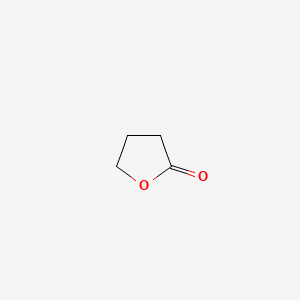| Cho JY et al. |
Savinin, a lignan from Pterocarpus santalinus inhibits tumor necrosis factor-alpha production and T cell proliferation. |
2001 |
Biol. Pharm. Bull. |
pmid:11217086
|
| Mukherjee A et al. |
hexA of Erwinia carotovora ssp. carotovora strain Ecc71 negatively regulates production of RpoS and rsmB RNA, a global regulator of extracellular proteins, plant virulence and the quorum-sensing signal, N-(3-oxohexanoyl)-L-homoserine lactone. |
2000 |
Environ. Microbiol. |
pmid:11220306
|
| Elasri M et al. |
Acyl-homoserine lactone production is more common among plant-associated Pseudomonas spp. than among soilborne Pseudomonas spp. |
2001 |
Appl. Environ. Microbiol. |
pmid:11229911
|
| Ravn L et al. |
Methods for detecting acylated homoserine lactones produced by Gram-negative bacteria and their application in studies of AHL-production kinetics. |
2001 |
J. Microbiol. Methods |
pmid:11240047
|
|
|
|
|
pmid:11242082
|
|
|
|
|
pmid:11254030
|
|
|
|
|
pmid:11259034
|
|
|
|
|
pmid:11262183
|
|
|
|
|
pmid:11282355
|
| den Tonkelaar I et al. |
Urinary phytoestrogens and postmenopausal breast cancer risk. |
2001 |
Cancer Epidemiol. Biomarkers Prev. |
pmid:11303591
|
|
|
|
|
pmid:11303913
|
| Chai Y et al. |
TrlR, a defective TraR-like protein of Agrobacterium tumefaciens, blocks TraR function in vitro by forming inactive TrlR:TraR dimers. |
2001 |
Mol. Microbiol. |
pmid:11309123
|
|
|
|
|
pmid:11312976
|
| Pietinen P et al. |
Serum enterolactone and risk of breast cancer: a case-control study in eastern Finland. |
2001 |
Cancer Epidemiol. Biomarkers Prev. |
pmid:11319174
|
| Lu Y et al. |
Inhibition of X-ray and doxorubicin-induced apoptosis by butyrolactone I, a CDK-specific inhibitor, in human tumor cells. |
2000 |
J. Radiat. Res. |
pmid:11329882
|
|
|
|
|
pmid:11339620
|
|
|
|
|
pmid:11340632
|
|
|
|
|
pmid:11348223
|
|
|
|
|
pmid:11356110
|
| Milton DL et al. |
The LuxM homologue VanM from Vibrio anguillarum directs the synthesis of N-(3-hydroxyhexanoyl)homoserine lactone and N-hexanoylhomoserine lactone. |
2001 |
J. Bacteriol. |
pmid:11371516
|
|
|
|
|
pmid:11375020
|
| Kilkkinen A et al. |
Determinants of serum enterolactone concentration. |
2001 |
Am. J. Clin. Nutr. |
pmid:11382665
|
| Zhang YJ et al. |
New phenolic constituents from the fruit juice of Phyllanthus emblica. |
2001 |
Chem. Pharm. Bull. |
pmid:11383602
|
|
|
|
|
pmid:11387029
|
| Mansergh G et al. |
The Circuit Party Men's Health Survey: findings and implications for gay and bisexual men. |
2001 |
Am J Public Health |
pmid:11392940
|
|
|
|
|
pmid:11397086
|
|
|
|
|
pmid:11397178
|
|
|
|
|
pmid:11398393
|
|
|
|
|
pmid:11398416
|
|
|
|
|
pmid:11399385
|
| Parkins MD et al. |
Pseudomonas aeruginosa GacA, a factor in multihost virulence, is also essential for biofilm formation. |
2001 |
Mol. Microbiol. |
pmid:11401724
|
| Lutter E et al. |
Distribution of quorum-sensing genes in the Burkholderia cepacia complex. |
2001 |
Infect. Immun. |
pmid:11402012
|
|
|
|
|
pmid:11403388
|
| Pessi G and Haas D |
Dual control of hydrogen cyanide biosynthesis by the global activator GacA in Pseudomonas aeruginosa PAO1. |
2001 |
FEMS Microbiol. Lett. |
pmid:11410352
|
| Schauder S and Bassler BL |
The languages of bacteria. |
2001 |
Genes Dev. |
pmid:11410527
|
|
|
|
|
pmid:11418062
|
| Smith RS et al. |
IL-8 production in human lung fibroblasts and epithelial cells activated by the Pseudomonas autoinducer N-3-oxododecanoyl homoserine lactone is transcriptionally regulated by NF-kappa B and activator protein-2. |
2001 |
J. Immunol. |
pmid:11418672
|
| Borchardt SA et al. |
Reaction of acylated homoserine lactone bacterial signaling molecules with oxidized halogen antimicrobials. |
2001 |
Appl. Environ. Microbiol. |
pmid:11425738
|
|
|
|
|
pmid:11446456
|
|
|
|
|
pmid:11453749
|
| Dong YH et al. |
Quenching quorum-sensing-dependent bacterial infection by an N-acyl homoserine lactonase. |
2001 |
Nature |
pmid:11459062
|
|
|
|
|
pmid:11468783
|
|
|
|
|
pmid:11476261
|
|
|
|
|
pmid:11485465
|
| Gardiner SM et al. |
Haemodynamic effects of the bacterial quorum sensing signal molecule, N-(3-oxododecanoyl)-L-homoserine lactone, in conscious, normal and endotoxaemic rats. |
2001 |
Br. J. Pharmacol. |
pmid:11487515
|
| Schauder S et al. |
The LuxS family of bacterial autoinducers: biosynthesis of a novel quorum-sensing signal molecule. |
2001 |
Mol. Microbiol. |
pmid:11489131
|
|
|
|
|
pmid:11493842
|
| Pour M et al. |
3-Phenyl-5-acyloxymethyl-2H,5H-furan-2-ones: synthesis and biological activity of a novel group of potential antifungal drugs. |
2001 |
J. Med. Chem. |
pmid:11495582
|
| Kim D et al. |
Lack of the burst firing of thalamocortical relay neurons and resistance to absence seizures in mice lacking alpha(1G) T-type Ca(2+) channels. |
2001 |
Neuron |
pmid:11498049
|
|
|
|
|
pmid:11506604
|
